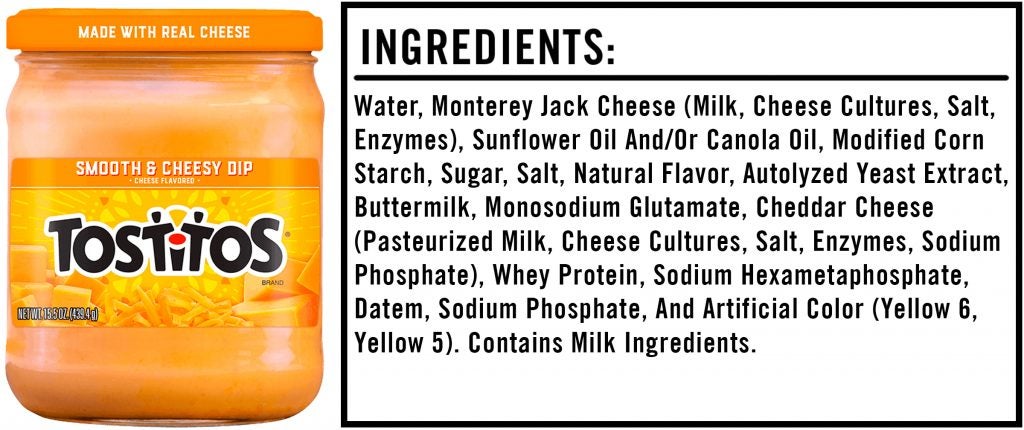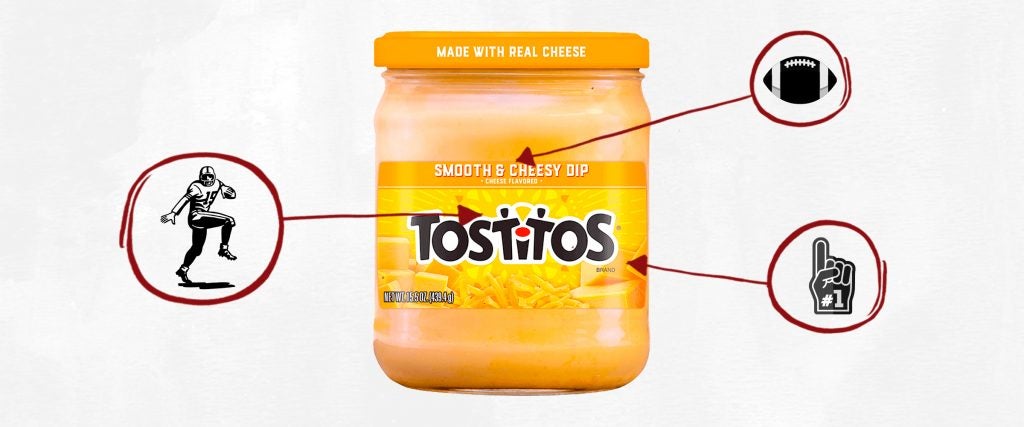Forget Thanksgiving. The most gluttonous day of the year is Super Bowl Sunday, where bowl after bowl and paper plate after paper plate is filled with finger-food bacchanalia that would make even the mad genius responsible for the TGI Friday’s appetizer selection blush (and certainly the ancient Romans). And so, all week leading up to game day, we’ll be offering up our own menu of scientific investigations, origin stories and majestic feats of snacking that not even the biggest sporting event of the year can top. Read all of the stories here.
Everyone knows there are only four acceptable dips to dunk your tortilla chips in if you actually want to make friends at a party as opposed to trying to present them with an annoying conversation starter: salsa, ranch dip, spinach dip, and of course, cheese dip. If you serve anything else as a conduit for chip submergence, you run the risk of only ruining everything.
As for the latter — cheese dip — you could certainly melt your own cheese and create a signature cheese dip of your own. But why run the risk of having a bubbling tub of orange-yellow lava spew residue all over the interior of your microwave when you could quickly run out to the local gas station to find some Tostitos Smooth & Cheesy Dip?
What, though, is actually in that neon jar of queso? I’m so glad you asked…

Ingredients
Water: You’ve got to hit your solid food item with the stink eye whenever you see that its primary ingredient is ordinary water.
Monterey Jack Cheese (Milk, Cheese Cultures, Salt, Enzymes): A white cheese first crafted by Franciscan Friars in Monterey, Alta California. It can be further fortified with peppers and herbs to produce pepper jack cheese if you desire.
Sunflower Oil and/or Canola Oil: Fun fact: The reason the word Canola exists in the first place (Canada, Oil, Low Acid) is because it was hypothesized that something called “rapeseed oil” would be a tougher sell. Both canola oil and sunflower oil have very high smoke points, rendering them ideal oils to cook food with while minimizing the harmful effects of oxidation.
Modified Corn Starch: Modified food starch is extracted from the source (corn, potato, tapioca, rice or wheat), then treated physically, enzymatically or chemically to partially break down the starch. It’s typically used as a batter to give foods a light, crispy texture, but in this case, it’s used to thicken the dip.
Sugar: Whatever sugar is contained in this cheesy dip, it’s so minimal that it doesn’t even register on the official chart of nutrition facts. To get a handle on what that actually means, be sure to review the FDA’s rounding rules for those charts.
Salt: This is one of those questionable cases where you simply can’t put any stock in the serving sizes. We can all clearly read on the label that the dip contains 200 milligrams of sodium per serving, which may seem like no big deal. However, you’re likely to polish off half a jar of this stuff, which is 1,400 milligrams, and 56 percent of your recommended daily sodium intake. All it takes is for you to pair this with enough Crispy Rounds, and you’re well on your way to surpassing the advised daily sodium level in 20 minutes or less. Be careful!
Natural Flavor: The extracts and essences of the real foods you’re consuming. For example, cheese infused with the essence of cheese.
Autolyzed Yeast Extract: This is the result when yeast is broken down into its individual components, and it naturally contains monosodium glutamate, better known as MSG. It’s added to food products to provide them with savory flavor profiles.
Buttermilk: Cultured nonfat buttermilk is the byproduct of churning butter out of cultured cream and is usually put into processed foods to add heartiness and oftentimes a creamy texture. It was primarily used in environments where regular milk soured rapidly in the heat.
Monosodium Glutamate: Again, otherwise known as MSG, monosodium glutamate is a naturally occurring amino acid (one of the building blocks of protein) that’s added to foods as a savory flavor enhancer. The food industry has no problem using MSG despite accusations leveled against it that it can cause health problems ranging from headaches and flushing to chest pains and nausea.
Cheddar Cheese (Pasteurized Milk, Cheese Cultures, Salt, Enzymes, Sodium Phosphate): Originating in the Somerset region of England, cheddar ultimately became the world’s most popular cheese variety, and if it weren’t for pizza, it would easily surpass mozzarella as the most widely produced cheese in the U.S. The “cheddaring” of cheese refers to the additional production step of kneading the curd with salt, cutting it into cubes to drain the whey and then stacking and turning it.
Whey Protein: The remnants left over from the aforementioned cheesemaking process, and the world’s bestselling form of supplemental protein. Also, if you’ve decided that you’d rather supplement your diet with the protein that actually ends up in the cheese, they sell jars of that as well.
Sodium Hexametaphosphate: This is commonly added to foods as a sequestrant, thickener, emulsifier and texturizer. It’s generally recognized as safe by the FDA, but animal studies have found some shocking side effects of consuming large amounts of this ingredient: Pale and swollen kidneys, increased kidney weight, bone decalcification, muscle fiber size changes, hyperplasia (which may lead to the gross enlargement of an organ) and severe skin irritations. However, since you’re not a lab rat, you probably have nothing to worry about.
Datem: Datem? I don’t even know ‘em! In all seriousness, datem is really an acronym that stands for “diacetyl tartaric acid esters of monoglycerides.” This is a dough conditioner — specifically a strengthener — and has been found to cause heart problems in lab rats, but only when they were fed the human equivalent of 350,000 milligrams of datem per day for several weeks.
Sodium Phosphate: Sodium phosphate may refer to any sodium salt combined with phosphoric acid. They’re usually added as texturizers and emulsifiers, which allows for the uniform dispersion of numerous ingredients. Please remember, this is also prescribed on its own as a legitimate medicine for evacuating the colon, so be forewarned that it comes laced with at least a touch of its own laxative.
Artificial Color (Yellow 6, Yellow 5): Everyone enjoys the hearty taste of a delicious color. These colors are intended to make foods appear more attractive, and who can blame the manufacturers for that? Can you imagine how few containers of cheesy sauce would be sold if they had a green or purple hue? In small doses, food coloring is no issue, but there is a study that potentially links consistent consumption of yellow 5 to some long-term DNA damage.
The Takeaway
This moderately sized jar has far more chemicals in it than the cheese you’d grab off the shelf and use as the foundation for a custom blend. If you absolutely must have a vat of store-bought, cheesy, yellow-y goo on hand for your guests to dip their chips (but hopefully not the tips of their fingers) into, you should reserve jars of Tostitos Smooth & Cheesy Dip for special occasions only. Otherwise, specialty cheese dips are one of those group party items that slow cookers are ideal for the preparation of.

